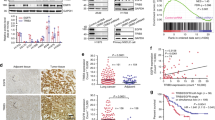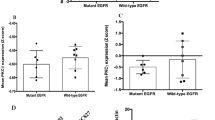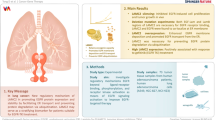Abstract
The epidermal growth factor receptor (EGFR) is a central regulator of tumor progression in human cancers. Cetuximab is an anti-EGFR antibody that has been approved for use in oncology. Previously we investigated mechanisms of resistance to cetuximab using a model derived from the non-small cell lung cancer line NCI-H226. We demonstrated that cetuximab-resistant clones (CtxR) had increased nuclear localization of the EGFR. This process was mediated by Src family kinases (SFKs), and nuclear EGFR had a role in resistance to cetuximab. To better understand SFK-mediated nuclear translocation of EGFR, we investigated which SFK member(s) controlled this process as well as the EGFR tyrosine residues that are involved. Analyses of mRNA and protein expression indicated upregulation of the SFK members Yes (v-Yes-1 yamaguchi sarcoma viral oncogene) and Lyn (v-yes-1 Yamaguchi sarcoma viral-related oncogene homolog) in all CtxR clones. Further, immunoprecipitation analysis revealed that EGFR interacts with Yes and Lyn in CtxR clones, but not in cetuximab-sensitive (CtxS) parental cells. Using RNAi interference, we found that knockdown of either Yes or Lyn led to loss of EGFR translocation to the nucleus. Conversely, overexpression of Yes or Lyn in low nuclear EGFR-expressing CtxS parental cells led to increased nuclear EGFR. Chromatin immunoprecipitation (ChIP) assays confirmed nuclear EGFR complexes associated with the promoter of the known EGFR target genes B-Myb and iNOS. Further, all CtxR clones exhibited upregulation of B-Myb and iNOS at the mRNA and protein levels. siRNAs directed at Yes or Lyn led to decreased binding of EGFR complexes to the B-Myb and iNOS promoters based on ChIP analyses. SFKs have been shown to phosphorylate EGFR on tyrosines 845 and 1101 (Y845 and Y1101), and mutation of Y1101, but not Y845, impaired nuclear entry of the EGFR. Taken together, our findings demonstrate that Yes and Lyn phosphorylate EGFR at Y1101, which influences EGFR nuclear translocation in this model of cetuximab resistance.
This is a preview of subscription content, access via your institution
Access options
Subscribe to this journal
Receive 50 print issues and online access
$259.00 per year
only $5.18 per issue
Buy this article
- Purchase on Springer Link
- Instant access to full article PDF
Prices may be subject to local taxes which are calculated during checkout






Similar content being viewed by others
Abbreviations
- BCRP:
-
breast cancer-resistance protein
- CRC:
-
colorectal cancer
- CtxR:
-
cetuximab-resistant
- CtxS:
-
cetuximab-sensitive
- DMSO:
-
dimethyl sulfoxide
- EGF:
-
epidermal growth factor
- EGFR:
-
epidermal growth factor receptor
- ER:
-
endoplasmic reticulum
- FBS:
-
fetal bovine serum
- FGFR:
-
fibroblast growth factor receptor
- HNSCC:
-
head and neck squamous cell carcinoma
- iNOS:
-
inducible nitric oxide synthase
- Lyn:
-
v-yes-1 Yamaguchi sarcoma viral-related oncogene homolog
- mAb:
-
monoclonal antibody
- NSCLC:
-
non-small cell lung cancer
- PGFR:
-
platelet-derived growth factor
- PI3K:
-
phosphatidylinositol 3-kinase
- PKC:
-
protein kinase C
- PLCγ:
-
phospholipase C-gamma
- qPCR:
-
quantitative PCR
- RTK:
-
receptor tyrosine kinase
- SFK:
-
Src-family kinases
- STAT:
-
signal transducers and activators of transcription
- Yes:
-
v-Yes-1 yamaguchi sarcoma viral oncogene
References
Yarden Y, Sliwkowski MX . Untangling the ErbB signalling network. Nat Rev Mol Cell Biol 2001; 2: 127–137.
Wheeler DL, Dunn EF, Harari PM . Understanding resistance to EGFR inhibitors-impact on future treatment strategies. Nat Rev Clin Oncol 2010; 7: 493–507.
Brand TM, Iida M, Wheeler DL . Molecular mechanisms of resistance to the EGFR monoclonal antibody cetuximab. Cancer Biol Ther 2011; 11: 777–792.
Pao W, Chmielecki J . Rational, biologically based treatment of EGFR-mutant non-small-cell lung cancer. Nat Rev Cancer 2010; 10: 760–774.
Gschwind A, Fischer OM, Ullrich A . The discovery of receptor tyrosine kinases: targets for cancer therapy. Nat Rev Cancer 2004; 4: 361–370.
Marmor MD, Skaria KB, Yarden Y . Signal transduction and oncogenesis by ErbB/HER receptors. Int J Radiat Oncol Biol Phys 2004; 58: 903–913.
Wang YN, Yamaguchi H, Hsu JM, Hung MC . Nuclear trafficking of the epidermal growth factor receptor family membrane proteins. Oncogene 2010; 29: 3997–4006.
Brand TM, Iida M, Li C, Wheeler DL . The nuclear epidermal growth factor receptor signaling network and its role in cancer. Discov Med 2011; 12: 419–432.
Carpenter G, Liao HJ . Trafficking of receptor tyrosine kinases to the nucleus. Exp Cell Res 2009; 315: 1556–1566.
Lo HW, Ali-Seyed M, Wu Y, Bartholomeusz G, Hsu SC, Hung MC . Nuclear-cytoplasmic transport of EGFR involves receptor endocytosis, importin beta1 and CRM1. J Cell Biochem 2006; 98: 1570–1583.
Hsu SC, Hung MC . Characterization of a novel tripartite nuclear localization sequence in the EGFR family. J Biol Chem 2007; 282: 10432–10440.
Wang YN, Yamaguchi H, Huo L, Du Y, Lee HJ, Lee HH et al. The translocon Sec61beta localized in the inner nuclear membrane transports membrane-embedded EGF receptor to the nucleus. J Biol Chem 2010; 285: 38720–38729.
Liao HJ, Carpenter G . Role of the Sec61 translocon in EGF receptor trafficking to the nucleus and gene expression. Mol Biol Cell 2007; 18: 1064–1072.
Lin SY, Makino K, Xia W, Matin A, Wen Y, Kwong KY et al. Nuclear localization of EGF receptor and its potential new role as a transcription factor. Nat Cell Biol 2001; 3: 802–808.
Hanada N, Lo HW, Day CP, Pan Y, Nakajima Y, Hung MC . Co-regulation of B-Myb expression by E2F1 and EGF receptor. Mol Carcinog 2006; 45: 10–17.
Lo HW, Hsu SC, Ali-Seyed M, Gunduz M, Xia W, Wei Y et al. Nuclear interaction of EGFR and STAT3 in the activation of the iNOS/NO pathway. Cancer Cell 2005; 7: 575–589.
Hung LY, Tseng JT, Lee YC, Xia W, Wang YN, Wu ML et al. Nuclear epidermal growth factor receptor (EGFR) interacts with signal transducer and activator of transcription 5 (STAT5) in activating Aurora-A gene expression. Nucleic Acids Res 2008; 36: 4337–4351.
Lo HW, Cao X, Zhu H, Ali-Osman F . Cyclooxygenase-2 is a novel transcriptional target of the nuclear EGFR-STAT3 and EGFRvIII-STAT3 signaling axes. Mol Cancer Res 2010; 8: 232–245.
Jaganathan S, Yue P, Paladino DC, Bogdanovic J, Huo Q, Turkson J . A functional nuclear epidermal growth factor receptor, SRC and Stat3 heteromeric complex in pancreatic cancer cells. PLoS One 2011; 6: e19605.
Huang WC, Chen YJ, Li LY, Wei YL, Hsu SC, Tsai SL et al. Nuclear translocation of epidermal growth factor receptor by Akt-dependent phosphorylation enhances breast cancer-resistant protein expression in gefitinib-resistant cells. J Biol Chem 2011; 286: 20558–20568.
Piccione EC, Lieu TJ, Gentile CF, Williams TR, Connolly AJ, Godwin AK et al. A novel epidermal growth factor receptor variant lacking multiple domains directly activates transcription and is overexpressed in tumors. Oncogene 2012; 31: 2953–2967.
Wang SC, Nakajima Y, Yu YL, Xia W, Chen CT, Yang CC et al. Tyrosine phosphorylation controls PCNA function through protein stability. Nat Cell Biol 2006; 8: 1359–1368.
Dittmann K, Mayer C, Fehrenbacher B, Schaller M, Raju U, Milas L et al. Radiation-induced epidermal growth factor receptor nuclear import is linked to activation of DNA-dependent protein kinase. J Biol Chem 2005; 280: 31182–31189.
Lo HW, Xia W, Wei Y, Ali-Seyed M, Huang SF, Hung MC . Novel prognostic value of nuclear epidermal growth factor receptor in breast cancer. Cancer Res 2005; 65: 338–348.
Hadzisejdic I, Mustac E, Jonjic N, Petkovic M, Grahovac B . Nuclear EGFR in ductal invasive breast cancer: correlation with cyclin-D1 and prognosis. Mod Pathol 2010; 23: 392–403.
Xia W, Wei Y, Du Y, Liu J, Chang B, Yu YL et al. Nuclear expression of epidermal growth factor receptor is a novel prognostic value in patients with ovarian cancer. Mol Carcinog 2009; 48: 610–617.
Psyrri A, Yu Z, Weinberger PM, Sasaki C, Haffty B, Camp R et al. Quantitative determination of nuclear and cytoplasmic epidermal growth factor receptor expression in oropharyngeal squamous cell cancer by using automated quantitative analysis. Clin Cancer Res 2005; 11: 5856–5862.
Li CF, Fang FM, Wang JM, Tzeng CC, Tai HC, Wei YC et al. EGFR nuclear import in gallbladder carcinoma: nuclear phosphorylated EGFR upregulates iNOS expression and confers independent prognostic impact. Ann Surg Oncol 2012; 19: 443–454.
Li C, Iida M, Dunn EF, Ghia AJ, Wheeler DL . Nuclear EGFR contributes to acquired resistance to cetuximab. Oncogene 2009; 28: 3801–3813.
Li C, Iida M, Dunn EF, Wheeler DL . Dasatinib blocks cetuximab- and radiation-induced nuclear translocation of the epidermal growth factor receptor in head and neck squamous cell carcinoma. Radiother Oncol 2010; 97: 330–337.
Hsu SC, Miller SA, Wang Y, Hung MC . Nuclear EGFR is required for cisplatin resistance and DNA repair. Am J Transl Res 2009; 1: 249–258.
Liccardi G, Hartley JA, Hochhauser D . EGFR nuclear translocation modulates DNA repair following cisplatin and ionizing radiation treatment. Cancer Res 2011; 71: 1103–1114.
Dittmann K, Mayer C, Kehlbach R, Rodemann HP . Radiation-induced caveolin-1 associated EGFR internalization is linked with nuclear EGFR transport and activation of DNA-PK. Mol Cancer 2008; 7: 69.
Biscardi JS, Maa MC, Tice DA, Cox ME, Leu TH, Parsons SJ . c-Src-mediated phosphorylation of the epidermal growth factor receptor on Tyr845 and Tyr1101 is associated with modulation of receptor function. J Biol Chem 1999; 274: 8335–8343.
Maa MC, Leu TH, McCarley DJ, Schatzman RC, Parsons SJ . Potentiation of epidermal growth factor receptor-mediated oncogenesis by c-Src: implications for the etiology of multiple human cancers. Proc Natl Acad Sci USA 1995; 92: 6981–6985.
Wheeler DL, Iida M, Dunn EF . The role of Src in solid tumors. Oncologist 2009; 14: 667–678.
Kim LC, Song L, Haura EB . Src kinases as therapeutic targets for cancer. Nat Rev Clin Oncol 2009; 6: 587–595.
Thomas SM, Brugge JS . Cellular functions regulated by Src family kinases. Annu Rev Cell Dev Biol 1997; 13: 513–609.
Bromann PA, Korkaya H, Courtneidge SA . The interplay between Src family kinases and receptor tyrosine kinases. Oncogene 2004; 23: 7957–7968.
Tice DA, Biscardi JS, Nickles AL, Parsons SJ . Mechanism of biological synergy between cellular Src and epidermal growth factor receptor. Proc Natl Acad Sci USA 1999; 96: 1415–1420.
Kloth MT, Laughlin KK, Biscardi JS, Boerner JL, Parsons SJ, Silva CM . STAT5b, a mediator of synergism between c-Src and the epidermal growth factor receptor. J Biol Chem 2003; 278: 1671–1679.
Ottenhoff-Kalff AE, Rijksen G, van Beurden EA, Hennipman A, Michels AA, Staal GE . Characterization of protein tyrosine kinases from human breast cancer: involvement of the c-src oncogene product. Cancer Res 1992; 52: 4773–4778.
Lu KV, Zhu S, Cvrljevic A, Huang TT, Sarkaria S, Ahkavan D et al. Fyn and SRC are effectors of oncogenic epidermal growth factor receptor signaling in glioblastoma patients. Cancer Res 2009; 69: 6889–6898.
Wheeler DL, Iida M, Kruser TJ, Nechrebecki MM, Dunn EF, Armstrong EA et al. Epidermal growth factor receptor cooperates with Src family kinases in acquired resistance to cetuximab. Cancer Biol Ther 2009; 8: 696–703.
Zhang J, Kalyankrishna S, Wislez M, Thilaganathan N, Saigal B, Wei W et al. SRC-family kinases are activated in non-small cell lung cancer and promote the survival of epidermal growth factor receptor-dependent cell lines. Am J Pathol 2007; 170: 366–376.
Fu YN, Yeh CL, Cheng HH, Yang CH, Tsai SF, Huang SF et al. EGFR mutants found in non-small cell lung cancer show different levels of sensitivity to suppression of Src: implications in targeting therapy. Oncogene 2008; 27: 957–965.
Koppikar P, Choi SH, Egloff AM, Cai Q, Suzuki S, Freilino M et al. Combined inhibition of c-Src and epidermal growth factor receptor abrogates growth and invasion of head and neck squamous cell carcinoma. Clin Cancer Res 2008; 14: 4284–4291.
Wheeler DL, Huang S, Kruser TJ, Nechrebecki MM, Armstrong EA, Benavente S et al. Mechanisms of acquired resistance to cetuximab: role of HER (ErbB) family members. Oncogene 2008; 27: 3944–3956.
Brand TM, Dunn EF, Iida M, Myers RA, Kostopoulos KT, Li C et al. Erlotinib is a viable treatment for tumors with acquired resistance to cetuximab. Cancer Biol Ther 2011; 12: 436–446.
Massie C, Mills IG . The developing role of receptors and adaptors. Nat Rev Cancer 2006; 6: 403–409.
Carpenter G . Nuclear localization and possible functions of receptor tyrosine kinases. Curr Opin Cell Biol 2003; 15: 143–148.
Wang SC, Hung MC . Nuclear translocation of the epidermal growth factor receptor family membrane tyrosine kinase receptors. Clin Cancer Res 2009; 15: 6484–6489.
Lo HW, Hung MC . Nuclear EGFR signalling network in cancers: linking EGFR pathway to cell cycle progression, nitric oxide pathway and patient survival. Br J Cancer 2006; 94: 184–188.
Zhao Y, He D, Saatian B, Watkins T, Spannhake EW, Pyne NJ et al. Regulation of lysophosphatidic acid-induced epidermal growth factor receptor transactivation and interleukin-8 secretion in human bronchial epithelial cells by protein kinase Cdelta, Lyn kinase, and matrix metalloproteinases. J Biol Chem 2006; 281: 19501–19511.
Xi S, Zhang Q, Dyer KF, Lerner EC, Smithgall TE, Gooding WE et al. Src kinases mediate STAT growth pathways in squamous cell carcinoma of the head and neck. J Biol Chem 2003; 278: 31574–31583.
Kasai A, Shima T, Okada M . Role of Src family tyrosine kinases in the down-regulation of epidermal growth factor signaling in PC12 cells. Genes Cells 2005; 10: 1175–1187.
Su T, Bryant DM, Luton F, Verges M, Ulrich SM, Hansen KC et al. A kinase cascade leading to Rab11-FIP5 controls transcytosis of the polymeric immunoglobulin receptor. Nat Cell Biol 2010; 12: 1143–1153.
Boerner JL, Demory ML, Silva C, Parsons SJ . Phosphorylation of Y845 on the epidermal growth factor receptor mediates binding to the mitochondrial protein cytochrome c oxidase subunit II. Mol Cell Biol 2004; 24: 7059–7071.
Acknowledgements
This project was supported, in part, by grant P30CA014520 from the National Cancer Institute, grant 1UL1RR025011 from the Clinical and Translational Science Award program of the National Center for Research Resources and the National Institutes of Health (DLW) by grant RSG-10-193-01-TBG from the American Cancer Society (DLW), and by NIH grant T32 GM08.1061-01A2 from Graduate Training in Cellular and Molecular Pathogenesis of Human Diseases (TMB).
Author information
Authors and Affiliations
Corresponding author
Ethics declarations
Competing interests
The authors declare no conflict of interest.
Rights and permissions
About this article
Cite this article
Iida, M., Brand, T., Campbell, D. et al. Yes and Lyn play a role in nuclear translocation of the epidermal growth factor receptor. Oncogene 32, 759–767 (2013). https://doi.org/10.1038/onc.2012.90
Received:
Revised:
Accepted:
Published:
Issue Date:
DOI: https://doi.org/10.1038/onc.2012.90
Keywords
This article is cited by
-
YES1 as a potential target to overcome drug resistance in EGFR-deregulated non-small cell lung cancer
Archives of Toxicology (2024)
-
Fisetin induces DNA double-strand break and interferes with the repair of radiation-induced damage to radiosensitize triple negative breast cancer cells
Journal of Experimental & Clinical Cancer Research (2022)
-
Dysregulated Redox Regulation Contributes to Nuclear EGFR Localization and Pathogenicity in Lung Cancer
Scientific Reports (2019)
-
The tyrosine phosphorylated pro-survival form of Fas intensifies the EGF-induced signal in colorectal cancer cells through the nuclear EGFR/STAT3-mediated pathway
Scientific Reports (2018)
-
miR-140-5p suppresses the proliferation, migration and invasion of gastric cancer by regulating YES1
Molecular Cancer (2017)



